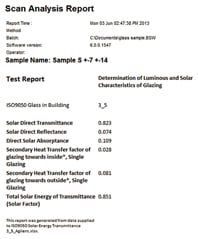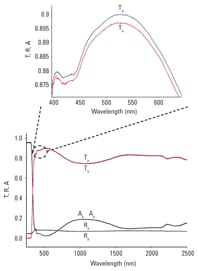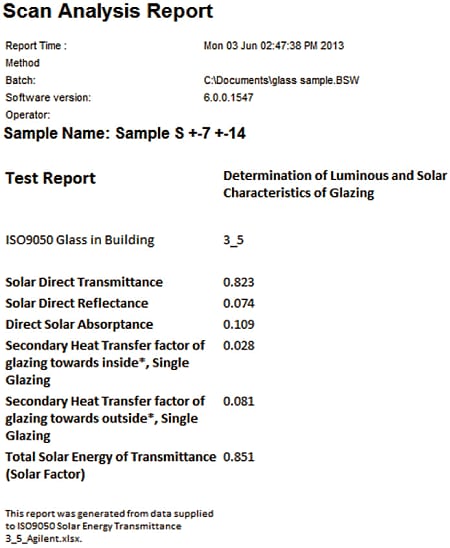Access Agilent eNewsletter, October 2013
>> Update My Profile | Subscribe to Access Agilent | Article Directory

Greener buildings and cooler cars with glass
By Travis Burt
Agilent Cary UV-Vis-NIR Product Manager
and Chris Colley
Agilent NPI Manager
Glass and glass-based products have been in use for thousands of years, but ways to measure their transmission of UV radiation, visible light, and thermal radiation are relatively new. Now, the Agilent Cary 7000 Universal Measurement Spectrophotometer (UMS) allows you to make these measurements with power and ease as never before possible.
Recent developments in composite products and specialty coatings allow you to tailor glass products like these to very specific functional needs, environmental conditions, and lighting demands. In addition, developers and users today are equally focused on the energy efficiency of the product and the requirements to block UV radiation, transmit visible light, repel thermal radiation (heat) in summer, and retain heat in winter.
Nationally and internationally recognized standards ensure that labs measure and classify glass products in a controlled and comparable manner. They include:
- ISO 9050 (2003): Glass in building – Determination of light transmittance, solar direct transmittance, total solar energy transmittance, ultraviolet transmittance, and related glazing factors
- EN 410: Glass in building – determination of luminous and solar characteristics of glazing
- ISO 13837 (2008): Road vehicles – safety glazing materials – method for the determination of solar transmittance
Acquire transmission and reflection data – without moving the sample
As described in a recent Application Note (5991-2514EN), we used the Agilent Cary 7000 UMS to measure and characterize a variety of automotive and architectural glazing products. The Cary 7000 UMS is a powerful and versatile spectral characterization tool that provides multiangle transmission and absolute reflection measurements in a motorized, fully automated package.
 Enlarge
Enlarge
Figure 1. This example of an ISO 9050 test report generated for an architectural glass sample shows the relevant measurements.
 Enlarge
Enlarge
Figure 2. Transmission, reflection, and the associated absorbance spectra (A=1-T-R) for an architectural glass sample (2 mm thick). Inset shows closer view and reveals important details.
Agilent’s Cary 7000 UMS performs transmission (%T) and absolute reflection (%R) measurements from the same point on the sample – without the need to move the sample between measurements. The in situ measurement of %T and %R from identical locations on the sample permits calculation of highly accurate absorbance (A = 1–T–R) data. This uniform methodology provides far greater insights into substrate (internal transmission) and coating properties. The capability to make consistent measurements ensures the highest quality R and T data for QA/QC operation and provides better insights for the research and development of glazing and coated glazing products.
Rapid, automated calculations
In addition to collection of the versatile T, R, and A data, you can execute dedicated calculations for the major international and regional glazing standards. We recently collected a complete set of transmission and reflection data using standard methods supplied with the Agilent Cary WinUV version 6 software. Calculations were fast with the built-in glass calculation and reporting tool.
Each of the standards mentioned in the bullets above has specific reporting parameters, which were automatically calculated and displayed in the Cary WinUV software report. We collected each set of data automatically and unattended, which highlights the true productivity benefit provided by the Cary 7000 UMS.
After the initial configuration and baseline measurement, each executed data collection needed less than three minutes. Tests that required reflection and transmission measurements on the same sample needed no further user interaction, because the data collection used the user-specified angle of incidence or reflection.
The examples shown in Figure 1 and Figure 2 demonstrate the high-quality data that leads to accurate characterization of these types of samples. For the spectra in Figure 2, we collected both s- and p-polarized spectral data at 7° angle of incidence. The inset provides a closer look at the transmission spectra in Figure 2 and reveals an expected separation of approximately 0.003 between s- and p-polarized spectra.
Agilent Application Note 5991-2514EN additionally shows data for EN 410 and ISO 13837 measurements.
Achieve best data quality and performance
The Agilent Cary 7000 UMS, with its standard software methods and reporting tools, efficiently calculates the optical properties of glass products used in automotive and building products. It reports the optical properties according to the regional and international glass standards – ISO 9050, ISO 13837, and EN 410. The Cary 7000 UMS is a powerful, productive, and ideal turnkey solution for routine QA/QC testing, as well as research and development of glass and glazing products.
For an easy-to-use solution that provides state-of-the art results for multiangle transmission and absolute reflection measurements, you can rely on the Agilent Cary 7000 Universal Measurement Spectrophotometer. Why not take a moment now to view our video and see the Cary 7000 UMS in action for yourself!
>> Update My Profile | Subscribe to Access Agilent | Article Directory

